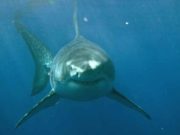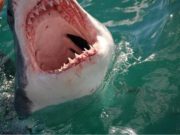Fisheries officials are investigating a dead fin whale that’s floating near the port in Vancouver
CBC News Posted: May 11, 2015 8:45 AM PT

The carcass of a dead fin whale has washed up in Burrard Inlet next to downtown Vancouver, and officials inspecting the young male whale said it was struck by a cruise ship.
The whale was likely hit north of Vancouver Island, according to a veteran whale biologist with Fisheries and Oceans Canada.
The carcass could be seen from buildings in downtown Vancouver that overlook Burrard Inlet. (CBC)
This is the third time since the 1990s that a fin whale has been found near Vancouver after being hit by a cruise ship, said John Ford, a research scientist with the department.
“It looks like it’s approaching maturity, could be full grown. We can’t see the whole body but it looks like it’s at least 40 to 50 feet at a minimum,” he said.

The whale’s body was found floating near a dock at Port Metro Vancouver, close to the Rogers Sugar refinery east of downtown. Someone tied the whale’s body to the dock, but it’s not clear who did this.
The whale was struck by the Seven Seas Navigator, a cruise ship which takes passengers on a sightseeing tours of coastal wildlife back and forth between Vancouver and Alaska. Crew members said they had no idea the whale came into the harbour on the bow of their cruise ship.
“We’re going to do a necropsy and look at what the cause of death was and the time of death,” said Paul Cottrell, a spokesman for Fisheries and Oceans.
2nd largest whale in world
Fin whales are the second largest whale in the world, after the blue whale.
They are listed as a “threatened” species and protected under the Species at Risk Act. Fin whale populations in B.C. were historically reduced by whaling, until they received protection in 1975.
A government website on their status lists “ship strikes” along with noise, pollution and entanglements as ongoing threats to their survival.
The species has a sleek, streamlined body, and is nicknamed the “greyhound of the sea,” because it can swim fast, up to 40 km/h, according to Fisheries and Oceans.
They are baleen whales, so they feed by lunging at prey with their mouth open, then filtering the water from the food using comb-like “baleen” plates in their mouth.
A witness initially reported the carcass as appearing to be a killer whale, or orca.
However, fisheries officials quickly confirmed the whale was a baleen whale — a group of whales that does not include killer whales — and later identified it as a fin whale.







